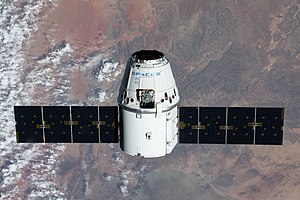 Dragon approaching the International Space Station during the CRS-20 mission, the last flight of the Dragon 1 | |||
| Manufacturer | SpaceX | ||
|---|---|---|---|
| Country of origin | United States | ||
| Operator | SpaceX | ||
| Applications | ISS logistics | ||
| Specifications | |||
| Dry mass | 4,201 kg (9,262 lb)[1] | ||
| Payload capacity | |||
| Crew capacity | 0 | ||
| Volume | |||
| Dimensions | |||
| Length | 6.1 m (20 ft)[1] | ||
| Diameter | 3.7 m (12 ft)[1] | ||
| Production | |||
| Status | Retired | ||
| Built | 14 | ||
| Retired | 13 | ||
| Lost | 1 | ||
| Maiden launch |
| ||
| Last launch | 7 March 2020 | ||
| Related spacecraft | |||
| Derivatives |
| ||
| Thruster details | |||
| Powered by | 18 × Draco | ||
| Propellant | N2O4 / CH6N2[6] | ||
| |||
| Part of a series on |
| Private spaceflight |
|---|
 |
| Active companies |
| Active vehicles |
| Contracts and programs |
| Related |
SpaceX Dragon 1 is a class of fourteen partially reusable cargo spacecraft developed by SpaceX, an American private space transportation company. The spacecraft flew 23 missions between 2010 and 2020. Dragon was launched into orbit by the company's Falcon 9 launch vehicle to resupply the International Space Station (ISS). It was succeeded by the Dragon 2 spacecraft which has both crewed and cargo versions.
During its maiden flight in December 2010, Dragon became the first commercially built and operated spacecraft to be recovered successfully from orbit. On 25 May 2012, Dragon became the first commercial spacecraft to successfully rendezvous with and attach to the ISS.[7][8][9] SpaceX contracted to deliver cargo to the ISS under NASA's Commercial Resupply Services program, and Dragon began regular cargo flights in October 2012.[10][11][12][13] With the Dragon spacecraft and the Northrop Grumman’s Cygnus, NASA sought to increase its partnerships with domestic commercial aviation and aeronautics industry.[14]
On 3 June 2017, the C106 capsule, largely assembled from previously flown components from the CRS-4 mission in September 2014, was launched again for the first time on CRS-11, after being refurbished.[15]
The last flight of the Dragon 1 spacecraft launched 7 March 2020 (UTC) on cargo resupply mission (CRS-20) to International Space Station (ISS). This was the last mission of SpaceX's first Commercial Resupply Services (CRS-1) contract, and marked the retirement of the Dragon 1 fleet. Further SpaceX commercial resupply flights to ISS under the second Commercial Resupply Services (CRS-2) program use the Cargo Dragon variant of the Dragon 2 spacecraft, which is capable of fully-automated docking with the ISS.[16]
- ^ a b c "SpaceX Brochure – 2008" (PDF). Archived from the original (PDF) on 20 March 2012. Retrieved 9 December 2010.
- ^ a b c "SpaceX Dragon specs". Archived from the original on 12 April 2017. Retrieved 15 May 2007.
- ^ "Audit Of Commercial Resupply Services to The International Space Station", Office of Inspector General, page 9, https://oig.nasa.gov/docs/IG-18-016.pdf
- ^ a b Cite error: The named reference
sx20090918was invoked but never defined (see the help page). - ^ Cite error: The named reference
LaunchAtLastwas invoked but never defined (see the help page). - ^ Cite error: The named reference
FAA2012was invoked but never defined (see the help page). - ^ Cite error: The named reference
FirstDockwas invoked but never defined (see the help page). - ^ Chang, Kenneth (25 May 2012). "Space X Capsule Docks at Space Station". New York Times. Archived from the original on 3 June 2015. Retrieved 25 May 2012.
- ^ "SpaceX's Dragon Docks With Space Station—A First". National Geographic. 25 May 2012. Archived from the original on 9 September 2015. Retrieved 28 May 2012.
- ^ "Liftoff! SpaceX Dragon Launches 1st Private Space Station Cargo Mission". Space.com. 8 October 2012. Archived from the original on 30 September 2015. Retrieved 8 October 2012.
- ^ Cite error: The named reference
oct8Launchwas invoked but never defined (see the help page). - ^ Cite error: The named reference
sepLaunchwas invoked but never defined (see the help page). - ^ "Press Briefed on the Next Mission to the International Space Station". NASA. 20 March 2012. Archived from the original on 5 April 2020. Retrieved 11 April 2012.
 This article incorporates text from this source, which is in the public domain.
This article incorporates text from this source, which is in the public domain.
- ^ "NASA Taps SpaceX, Orbital Sciences to Haul Cargo to Space Station". Space.com. 23 December 2008. Archived from the original on 5 August 2010. Retrieved 1 March 2011.
- ^ Mark Carreau (3 June 2017). "SpaceX Advances Space Hardware Reuse With Latest Flight". Aviation Week Network.[permanent dead link]
- ^ "Falcon 9 launches final first-generation Dragon". spacenews.com. 7 March 2020. Archived from the original on 10 March 2020. Retrieved 10 March 2020.
